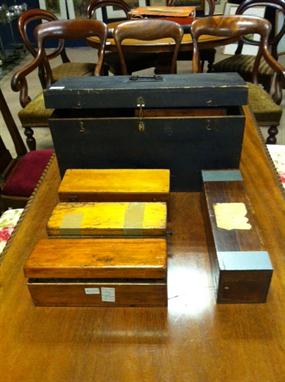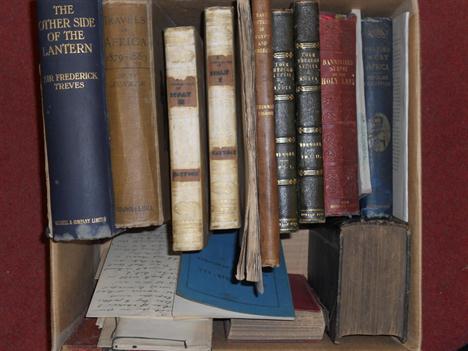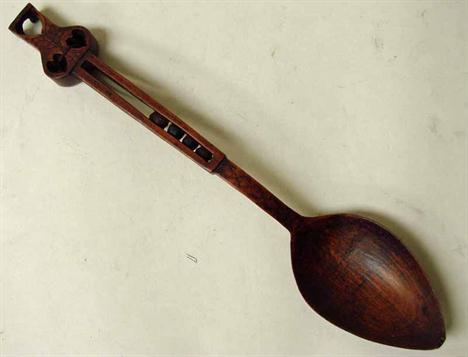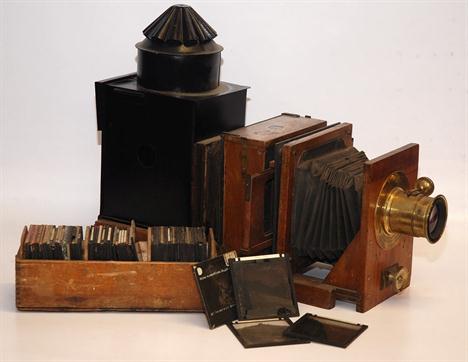We found 41682 price guide item(s) matching your search
There are 41682 lots that match your search criteria. Subscribe now to get instant access to the full price guide service.
Click here to subscribe- List
- Grid
-
41682 item(s)/page
Mixed lot including a variety of items including 2x Tri-ang Arkitex construction sets (F/G, boxed, not checked if complete); diecast models by Matchbox and Solido (G);Tri-ang US Frontier box set (F with P box, may be incomplete); Mah Jong set (contains 144 tiles and a selection of counters); 11 Police buttons; AA vehicle badge; selection of colour painted Magic Lantern glass slides (12 pink border depicting various cartoon characters, 12 orange border with `E.P.` in corner), etc.
A pair of Staffordshire ice pails, covers and liners, mid 19th century, decorated with titled landscape panels to either side, the first 'The Temple of Jupiter, Athens' and 'Constantinople', the second 'The Lantern of Diogenes' and 'Albania' on cobalt and gilt ground, gilt branch form handles to lower half of body, the covers and circular bases decorated with reserves of floral sprays, gilded flower head finials, (at fault) 32.5cm high (2)
A box containing approx 50 glass lantern slides, depicting fairy tales - Hansel & Gretel, Snow Which etc. The box is addressed to a German Prisoner of War, posted in Frankfurt in 1919 to Peter Fagish B130408 POW camp Fingley Farm Camp also containing pages of humour from German war camp 1947.
Travel. BRYDONE (P) A Tour Through Sicily and Malta, 2 vols, 3rd ed, 1774, half morocco (lacks map); JUNKER (Dr W) Travels in Africa, 1891, somewhat worn; KELLSALL (C) Classical Excursion From Rome to Arpino, 1821, in paper wrapper; TREVES (Sir F) The Other Side of The Lantern, 1905 re-print, stained cloth; BANNISTER (J.T) A Survey of The Holy Land, circa 1850, plates; FOLEY (Henry) Album of Sketches, 1879-81, with 11 small sketches only; EDWARDS (Brian) History of West Indies, 2nd ed, 1794, vol I only, with folding map of Jamaica and another, disbound, etc. (17)
A PINE BOX COMPRISING OF FORTY TWO MAGIC LANTERN SLIDES SOME BY SLIDE HOUSE 52 VICTORIA STREET LONDON, VARYING SUBJECTS INCLUDING BALLOON JOURNEY SHOWING SNOW WAVES, MAORI TRADITIONAL DANCE, WAKE OF THE NIMROD THROUGH PACK ICE, THE SITE OF THE WINTER QUARTERS, CREW AND PONIES, MIDDLE EASTERN ARTIFACTS, UNION CASTLE LINE SHIPS, AFRICAN `A THOUSAND MILES UP THE CONGO`. ETC...
A Chinese cloisonne enamel crane, with slender neck curved in an `s` shape, a red crest, the body enamelled in white within gilt outlines, the long legs intricately detailed with scales, the claws supported on a double pedestal decorated with lotuses and foliage on a turquoise ground, 72cm high, Qing dynasty (18th-19th century). Provenance: Originally purchased by Louis Joseph, 28 Knightsbridge, in 1951, for £43, as the receipt indicates.清掐丝珐琅仙鹤; 十九世纪或更晚 掐丝珐琅花卉八宝底座CRANES AND THE POWER OF IMAGES AT THE COURT OF THE QING BENEDETTA MOTTINOCranes are an important component of the Chinese decorative system which is based on the use of images whose auspicious symbolism was conveyed by their intrinsic qualities and the homophonic nature of the Chinese language. The underlying principle to such a system was the belief that all natural phenomena and things on Earth were an expression of Heaven’s will towards the human conduct. Auspicious events, therefore, were reproduced in writing or images in China and believed to function just like their physical counterpart and thus perpetuate their benign effects. In this way, buildings, tombs, gardens, paintings, ceramic, lacquer, metal wares and textiles were decorated with flowers, birds, animals and other auspicious symbols. Cranes have a long-lived tradition of connection with immortality beliefs in China. As birds with a long life span, they were associated with longevity, immortality and wisdom, especially following the rise of Daoism from the Han dynasty. We may recall the flying cranes appearing on the domed ceiling of the tomb of Wang Chuzhi of the Five Dynasties and the high-ranking tombs of the Liao, and the frequent occurrence of cranes in relation to the miraculous rebirth as immortal beings in vernacular literature dating from the 12th century. Cranes were also praised for their ability to dance to music and described in the Ruiying tu of the sixth century BC as gathering around the legendary Yellow Emperor as he practiced music on Kunlun mountains, accompanying scholars as they played music in Tang and Song paintings and appearing in official celebrations and gatherings. Accompanying the rites, music provided a moral and physical definition to a dynastic rule. In this context, therefore, cranes were interpreted as heavenly indicators of the emperor’s benevolence and sage governance. It may not be incidental that the word for crane is in fact homophone with the Chinese word for harmony he. Cranes became even more closely related to a successful reign/emperor during the prosperous period of Northern Song Emperor Huizong (r. AD 1100-1126) as the search for auspicious images increased and the Xuanhe ruilan ce, comprising some thousand volumes recording auspicious sightings, was compiled. During this time, cranes appeared as pennants and employed as part of the imperial regalia that accompanied many official affairs on the court. Cranes also appeared in many Song court paintings. Cranes above Kaifeng, in particular, has been attributed to or commissioned by Emperor Huizong. The work depicts twenty cranes appearing in flight above the Golden Gate to the Imperial Palace on the 3rd day of the Lantern Festival - believed to be 26th February 1126) as if sent by Heaven to sanction and celebrate one of the most glorious days of Huizong’s reign when the court was at its highest splendour and the emperor was united with his subjects as they wished him longevity for the year to come.It may therefore be little surprising that cranes were also ubiquitously found at the court of the Qing emperors, especially that of Qianlong (AD 1735-1795), emperor known for his virtuousness and appreciation of antiquity. In this instance, cranes not only appeared in paintings but even three-dimensionally as components of miniaturised immortal palaces made of jades, agate and other precious stones and in greater size flanking the imperial throne, such as the one presented here. Standing on an elaborate cloisonné stand, not only does this creature serve a highly visual appealing purpose, but in much the same way as the glorious emperors of the past, was surely employed by the Imperial House of the Qing as a powerful symbol embodying the contemporary brilliance of the Chinese Empire.For the occurrence of cranes in the arts of the Qing dynasty see Pine, plum and cranes pained by Shen Quan (AD 1682-1760), Cranes against Sky and Waters by Yu Xing (AD 1692-after 1767), and the miniature landscape representing the immortal island of Penglai in gold, pearls and precious stones, all part of the Imperial Collection at the Palace Museum in Beijing and illustrated in the Royal Academy catalogue China. The Three Emperors 1662-1795, 2005, figs 268-269.For an account on the interpretation of auspicious images see Jessica Rawson, The power of images: the model universe of the First Emperor and its legacy, in Historical Research 75, May 2002, p.123-154 and The Auspicious Universe, by the same author, in China. The Three Emperors 1662-1795, Royal Academy, 2005, p. 270-305.For an account on the interpretation of cranes at the court of Huizong see Peter Sturman, Cranes above Kaifeng: The Auspicious Image at the Court of Huizong, in Ars Orientalis, 1990, p. 33-68.For the occurrence of cranes during the Han dynasty see Anna Seidel, Post-Mortem Immortality or The Taoist Resurrection of the Body, 1987.
20th Century Japanese Two minutely detailed vistas, one of a coastal nature with figures climbing a steep embankment to the shore, the other of a domestic scene by a river, together with one larger view of Mount Fuji at dusk as lantern bearers tug a two man kayak down steam, watercolour with pen and ink over crepe paper, uniformly framed and mounted under glass (3)
-
41682 item(s)/page




















































